Affiliate disclosure: This post may contain affiliate links. Please see our Privacy Policy.
There aren’t that many mushrooms you can forage year-round, but orange witch’s butter will pop out of softwood logs any day of the year. That includes -20 days right in the middle of our zone 4 Vermont winter. While it may not taste like much, it is edible, and it’s year-round survival food.
Witch’s butter mushrooms are also medicinal, and they’ve been shown to have anti-tumor properties, as well as the potential to treat certain respiratory conditions.
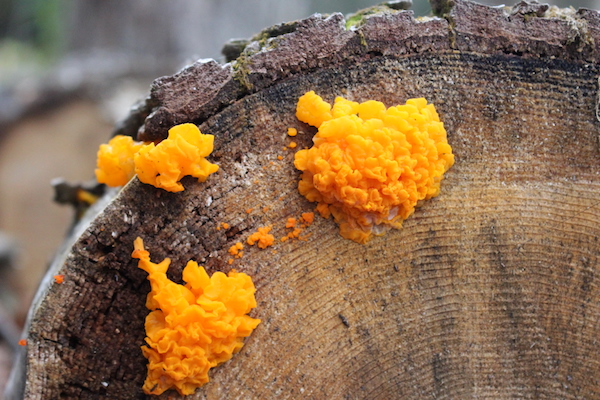
Many years ago, joined a group of a dozen others for a guided mushroom walk with a well-known local forager. One of the first mushrooms she showed us was witch’s butter (Dacrymyces palmatus), and she told a story about how her young granddaughter would eat it anytime they were in the woods together.
It’s not hard to spot a common, bright orange mushroom and the little girl seemed to be drawn to it. She’d ask for a positive ID from grandma before popping the orange jelly fungus in her mouth again and again.
A short while later, the little girl finally got a diagnosis for a condition she’d been battling for some time, and it turns out she had some sort of respiratory problem. Our foraging guide believed that her granddaughter had the intuition to self-medicate and that the witch’s butter helped her limp along until she had a proper diagnosis.
The story stuck with me, and every time I see witch’s butter mushrooms in the woods I think of a sick little girl I’ve never met.
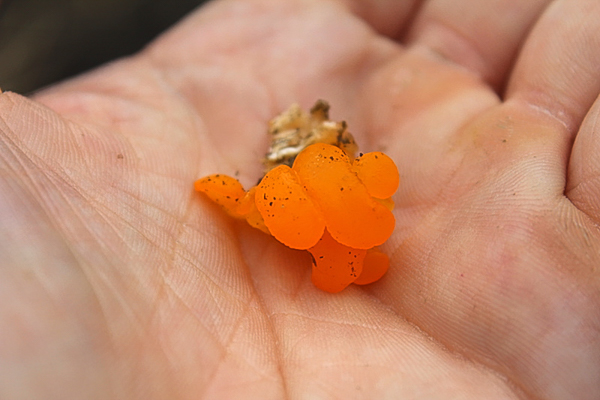
Identifying Witch’s Butter
There are three types of mushrooms with the common name “witch’s butter” and all are generally considered edible. They look quite similar, and two of the three are practically identical, with yellow jelly-like fruiting bodies.
All of these are bright orange to yellow, jelly like, and grow on the side of wood. They have overlapping ranges, occuring in temperate forests around the world. While many of them have physical similarities, each species has a unique ecology and evolutionary history. Telling them apart can be difficult due to their similarity, but if you know what ecological clues to look for, you can identify these species based on their habitat. All of these species can occur year round, but typically fruit during wet periods in fall and winter.
Two of the species (sometimes called Yellow Jelly Fungus) grow on hardwoods, while the third which is more orange, grows on softwood species and is appropreately called Orange Jelly Fungus. But they’re all refered to as witches butter, and used similarly.
Yellow Jelly Fungus
Naematelia aurantia (also called Tremella aurantia) is commonly found on Oak and other hardwoods. This species is actually a parasite of another fungus called False Turkey Tail (Stereum). For this reason, this mushroom is often found growing right alongside its host fungus. The False Turkey Tail looks like a lot like a regular Turkey Tail but is typically smaller, less robust, and has visible pores on its underside. Naemateelia aurantia is widely cultivated and consumed in China for its medicinal properties. It is particularly valued for its “beauty enhancing” properties and is believed to be anti-aging and said to improve skin health.
Tremella mesenterica is also a parasite found on hardwoods but is typically found on smaller twigs rather than trunks or branches. It also does not parasite the False Turkey Tail but instead, a brown-white crust fungus called Peniphora that also grows on the surface of the logs. It has a close relative called the Snow Fungus (Tremella fuciformis) which is very similar but translucent and also highly valued in China.
Tremella mesenterica and Tremella aurantia mushrooms are yellowish-orange in color and found on hardwood trees with bark still attached. They’re parasitic of other mushrooms, specifically mushrooms that help decompose trees.
For that reason, they’re commonly found on downed hardwoods.
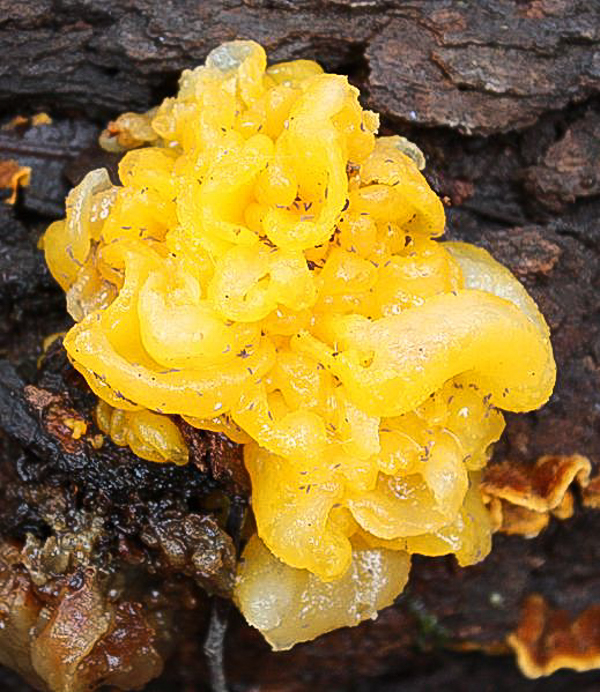
Orange Jelly Fungus
Dacrymyces chrysospermus (also called Dacrymyces palmatus) is unique as it is the only species that is found growing on downed conifer wood. So if you find a witches butter on a pine, spruce, fir, or other coniferous logs than you know you are working with this specific species. It is believed to be saprobic, feeding directly on the dead woody material.
It is known as orange jelly fungus and is much more orange in color. While the yellow jelly fungus grows on hardwoods with bark attached, the orange species grows on conifers such as pine and hemlock, and prefers barkless pieces.
Unlike the other two “witch’s butter” species, it is not parasitic on other mushrooms but rather is a wood decomposer.
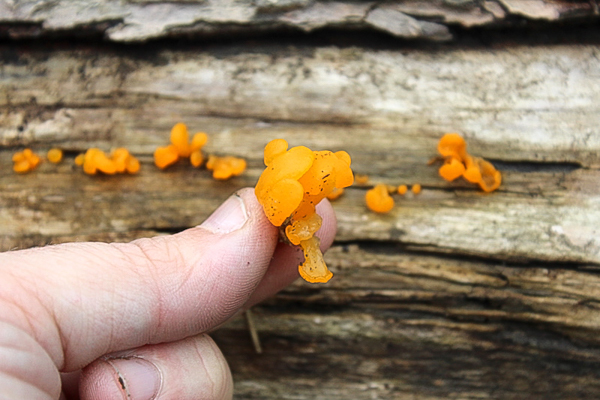
Is Witches Butter Edible?
Both types of jelly fungus, which use the common name “witches butter” are edible, that’s not up for debate in all the sources I’ve found to date. To the best of my knowledge, there are no toxic look-alikes, but since witch’s butter isn’t commonly eaten, it’s hard to be sure there’s not a toxic look-alike lurking out there that no one’s happened across yet.
Even though the general consensus is that witch’s butter is edible, there is considerable debate about whether or not it can be eaten raw.
It’s often referred to as a “survival mushroom” that’s available year-round, easy to identify and you can just pop it in your mouth. My foraging guide was clearly comfortable letting her young granddaughter eat it raw.
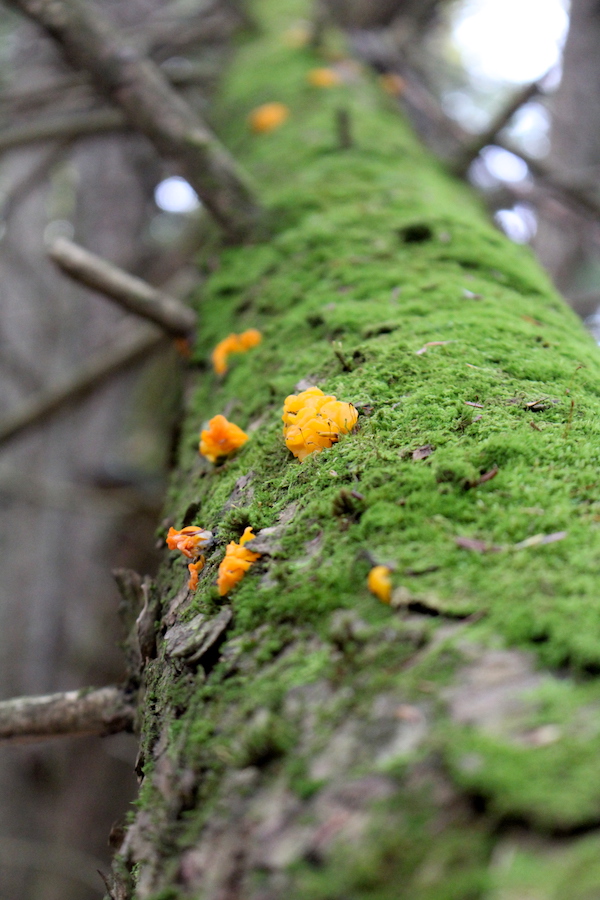
Others say that it has to be cooked, either boiled or steamed. As a general rule of thumb, you should always cook any mushroom, wild or cultivated. While many people may be able to get away with eating them raw, I’d hate to be the one that doesn’t have the right constitution and find out the hard way.
This is especially true when foraging with kids. My three-year-old daughter is a budding mushroom hunter, and she’ll often collect specimens for my inspection. I’ve tried to instill in her one core rule, that a mushroom must always be cooked, largely because it prevents her from popping them in her mouth in the wild.
That’s true for adults too, and just the act of bringing a mushroom home makes you think on it a bit harder. The excitement of the find has passed, and you can take a second look in the kitchen.
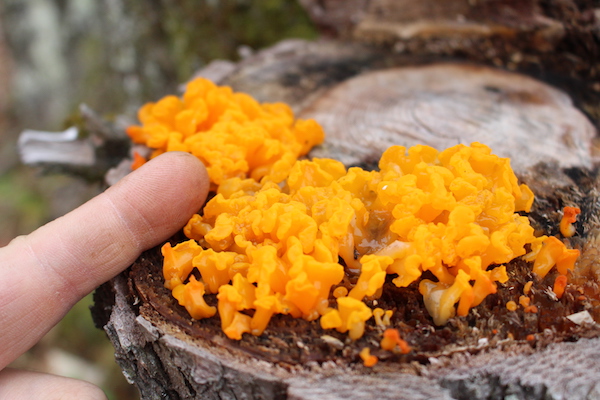
What Does Witches Butter Taste Like?
Edible or not, witch’s butter doesn’t really have a taste. It’s hard to describe, but I couldn’t pin down a taste at all in these little orange jelly mushrooms. There was something there though.
My mom happened to be visiting, and without explanation, I handed her a mass of witch’s butter and said, “Tell me what this tastes like to you…”
Clearly, my mom’s trusting, but only to a point. She touched the mushroom to the tip of her tongue, thought about it, and said,
“It doesn’t really taste like anything, but it gives me the sensation of Vicks vapor rub. It’s cooling, and that spot on my tongue is tingling a bit. That’s it, it’s tastes like ben gay, and it makes my tongue feel like I’ve rubbed the spot with icy hot or something.”
She breathed in a few times and said, “See, I can still feel the coolness on my tongue.”
I popped another one in my mouth and chewed, and she nailed it. No taste, but more of a sensation. It is kinda slimy and doesn’t really “taste” like anything, but it does give a bit of a tingle to the mouth.
It makes sense, given that it’s supposed to be a medicinal mushroom for lung-related issues. A cooling, Vicks vapor rub sensation seems just about right.
Both of us tested the flavor raw in the woods, and we both spit after our taste. I cannot say whether it causes any digestive upset from eating it raw, as I wasn’t willing to chance it.
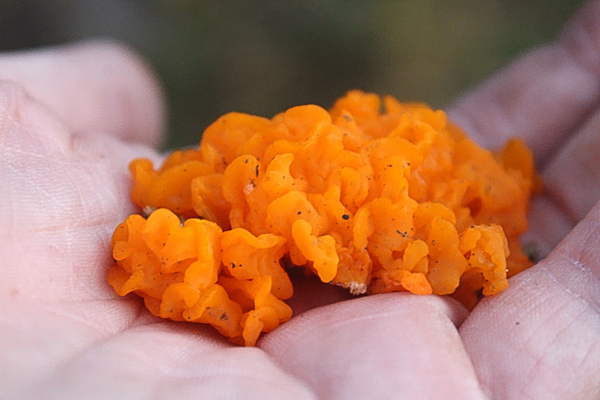
Cooking Witch’s Butter
Just because something’s edible, doesn’t mean there’s a great reason to eat it. Witch’s butter is a neat curiosity, with exciting medicinal potential, but it doesn’t taste like much.
It quickly shrives down to nothing if left on the counter after picking, though it’ll rehydrate quickly. Many foragers suggest cooking it into a soup for added nutrition.
I found one recipe that crispy fries it in a breading with cajun seasoning. They say it tastes just like calamari, which I’d believe given the texture.
Beyond that, I haven’t found any witch’s butter recipes, or anyone claiming much experience eating it. There’s plenty of it on my land, so maybe I’ll try cooking them over the next several months trying to develop some tasty recipes for an otherwise tasteless mushroom.
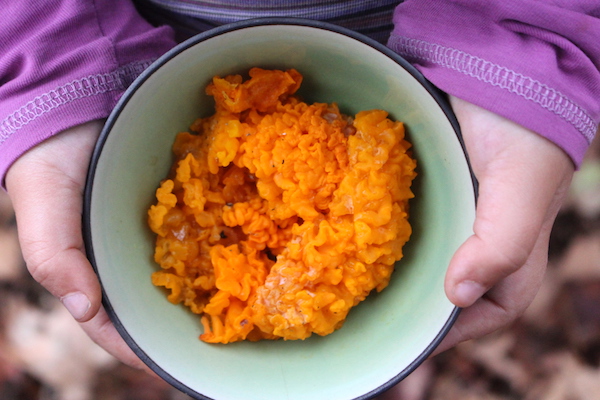
Witch’s Butter Folklore
Since orange witch’s butter is a decomposer that often sprouts in barkless softwood after a heavy rain, it’s not uncommon for it to sprout from exposed door frames. Historically, witch’s butter sprouting from your doorframe was seen as a sign that your household had come under a spell, and stabbing the mushrooms with a sharp tool was the best remedy.
Once the wood is infected, it tends to put out a bloom after each heavy rain, which is likely to keep a family paranoid of evil spirits if they don’t replace that beam.
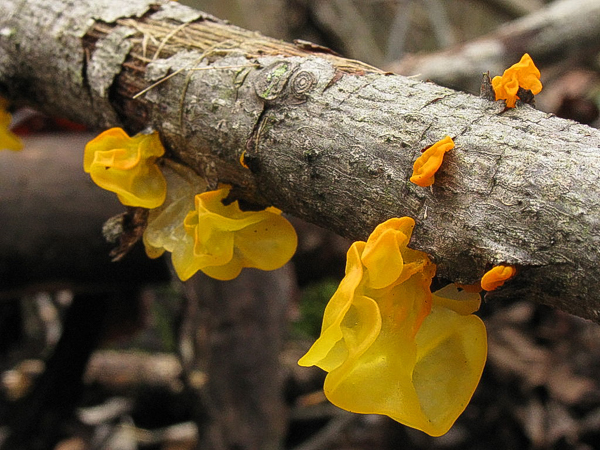
More Beginning Mushroom Foraging Guides
Looking for more mushroom foraging guides for beginners? Here’s a few more to keep you going!
- Reishi Mushrooms (also grows on softwood)
- Morel Mushrooms
- Chanterelle Mushrooms
- Lion’s Mane Mushrooms
- Shaggy Mane Mushrooms
- Puffball Mushrooms
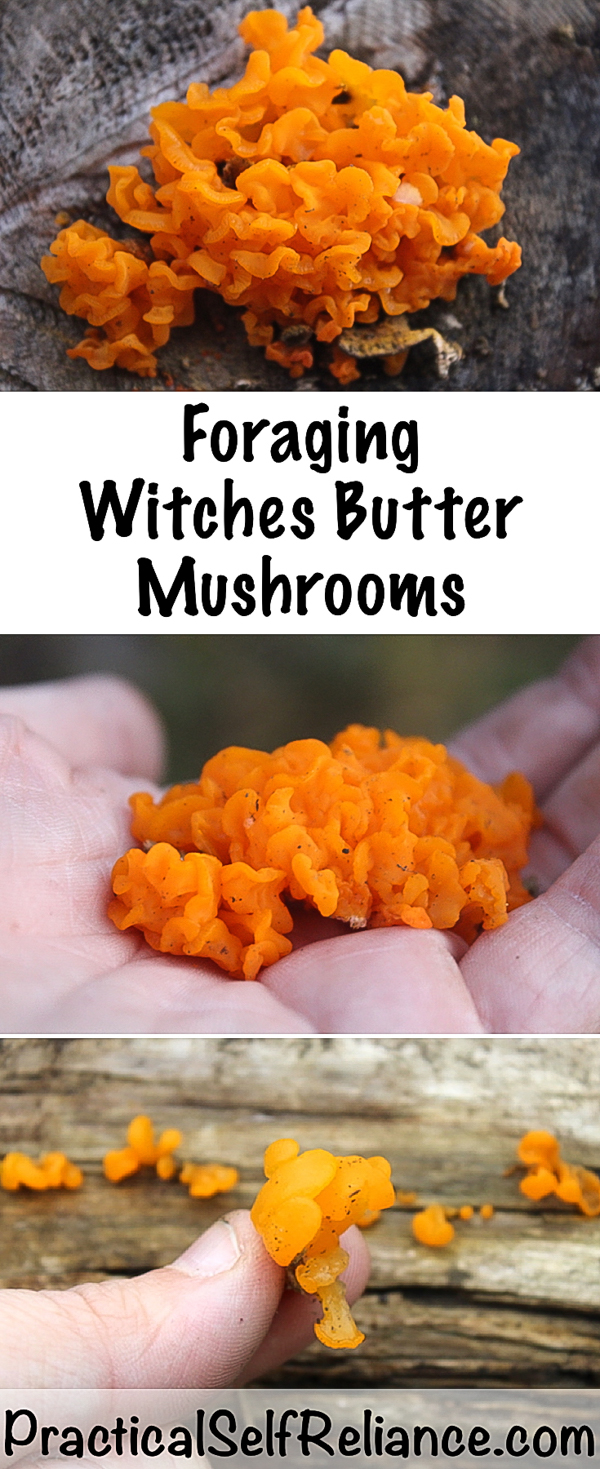

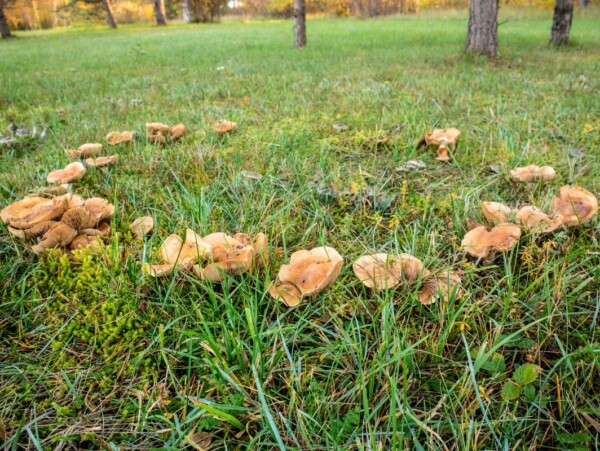
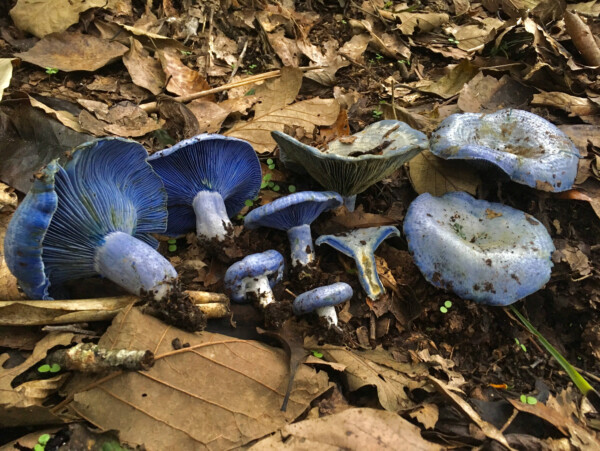
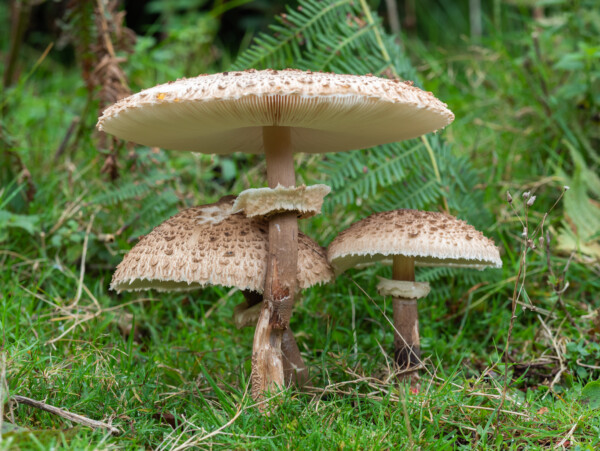
I bought one at a specialty market yesterday and sautéed it with other mushrooms following a Japanese mushroom recipe. It was AMAZING! It had the consistency of cooked beef fat from the end cap of a steak (in all the good ways and my apologies to the vegetarians and vegans out there). The sautée was a long cook to get the mushroom medley more towards crispy rather than soft and the slices of witch’s butter (I made them about a centimeter thick) held up beautifully. They’re definitely a good addition for sautéed dishes and curries.
That sounds amazing!
I have made hot and sour soup using wood ear and witch’s butter (and fresh ramps when available), and added a little egg drop as well. It tastes pretty good I must say. The wood ear adds a little woody flavor and the witch’s butter just seems to take on the other flavors of the chicken broth and chili oil.
I recently found a candied witch’s butter recipe I want to try soon. Basically making muchroom gummies or fruit snacks.
Those all sound very interesting. Thanks so much for sharing. You will have to let us know how your gummies turn out.
Hey! Love your content! Do you have a wild edible book? Your images along with your great ability to describe wild edibles would make a fantastic book! I have a few books but I’m always disappointed because they usually only have 1 small blurry photo, if you make a book, I’ll buy it! Would be wonderful to have a book with 4 or more clear images per wild edible! Or pintables from your site much like people who have recipes blogs!
Thank you so much. We’re so glad that you’re enjoying the blog. We don’t have any books yet but we have had lots of requests. We appreciate your suggestions and we will keep them in mind.
I have collected a lot of this, soaked it in simple syrup, drained it, then dehydrated it slightly until it resembles a gummy. I have eaten quite a bit of this without any trouble. Prepared this way gives it an interesting mild mushroom but still pleasant and sweet flavor. This inspires me to try a small bit raw and continue to forage. Thanks for sharing your experience!
That’s very interesting. Thanks so much for sharing.
I photographed one like this a few years ago – also in Vermont. However, it was a bright neon orange and was f=growing on a softwood (pine or cedar) log with plenty of bark on it. Here is the pic: https://www.flickr.com/photos/beautyisintheeye2/26630814579/in/dateposted-public/
How does one go about storing this for later use?
I imagine dehydrating would be the best method.
Thank you so much for sharing! And educating us on the different types of mushrooms that are available with different characteristics. Mushroom it is really magical, it has endless capabilities!
Hi! Ashley!
Thank you for this! I wonder, though – are the any toxic look-alikes, to the witch’s butter?
Based on my research and to the best of my knowledge there are no toxic look alikes…That said, I’m always even more cautious when working with a mushroom that’s not commonly eaten. I always have this thought in the back of my mind that there could be toxic look-alikes out there, but no one’s happened to eat them yet. That seems less likely with widely foraged mushrooms like chanterelles and morels, but with something like witches butter that’s rarely eaten, I always wonder…
For me, since it doesn’t taste like anything, seeing witches butter in the landscape is more of a novelty than something I want to risk collecting and eating on a regular basis.
You have eaten it prior and can confirm it doesnt taste like anything? I see this fungus all the time and am quite curious in trying it now..
I notice a mild apricot flavour when trying this one. Anyone else get that?
I’m curious, as well. Have you personally prepared and eaten this mushroom?
I’ve eaten them raw, and while there’s not really a “taste” there is a sensation in your mouth. I gave one to my mom, and didn’t really give her any info besides just asking “what do you think?” She chewed it, and said it’s tastes like ben gay, and then corrected herself and said it deosn’t taste like anything, but that it gives her tonge that “icy hot” sensation that vicks vapor rub gives you in the lungs when you rub it on your chest. She breathed in a few times and said, “see, i can still feel the coolness on my tonge.”
I ate another one, and yes, that’s it. It is kinda slimy, and doesn’t really “taste” like anything, but it does give a bit of a tingle to the mouth. Maybe that’s one of the way’s it impacts the lungs, as it’s supposed to be like a vicks vapor rub thing as a lung issue medicinal mushroom, but as to the specifics of that I really don’t know.
Hi I found some black ones,soft jelly like inside and leaf like outside,no real taste,maybe a bit of a tingle on the tongue? North central Arkansas on pin oak branches.
It’s possible that you may have found another variety of jelly fungi. There are many different varieties.
I’ve just read that this is a good treatment for respiratory ailments, used by Chinese doctors.
Maybe needs study by specialists for this.
I read that is was given to someone who asked for a cure for COVID, + this was left on their doorstep the next day. That is is good for respiratory conditions makes sense.